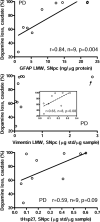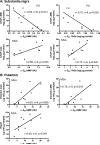Low levels of astroglial markers in Parkinson's disease: relationship to α-synuclein accumulation
- PMID: 26102022
- PMCID: PMC4641013
- DOI: 10.1016/j.nbd.2015.06.010
Low levels of astroglial markers in Parkinson's disease: relationship to α-synuclein accumulation
Abstract
Although gliosis is a normal response to brain injury, reports on the extent of astrogliosis in the degenerating substantia nigra in Parkinson's disease (PD) are conflicting. It has also been recently suggested that accumulation of nigral α-synuclein in this disorder might suppress astrocyte activation which in turn could exacerbate the degenerative process. This study examined brain protein levels (intact protein, fragments, and aggregates, if any) of astroglial markers and their relationship to α-synuclein in PD and in the positive control parkinson-plus conditions multiple system atrophy (MSA) and progressive supranuclear palsy (PSP). Autopsied brain homogenates of patients with PD (n=10), MSA (n=11), PSP (n=11) and matched controls (n=10) were examined for the astroglial markers glial fibrillary acidic protein (GFAP), vimentin, and heat shock protein-27 (Hsp27) by quantitative immunoblotting. As expected, both MSA (putamen>substantia nigra>caudate>frontal cortex) and PSP (substantia nigra>caudate>putamen, frontal cortex) showed widespread but regionally specific pattern of increased immunoreactivity of the markers, in particular for the partially proteolyzed fragments (all three) and aggregates (GFAP). In contrast, immunoreactivity of the three markers was largely normal in PD in brain regions examined with the exception of trends for variably increased levels of cleaved vimentin in substantia nigra and frontal cortex. In patients with PD, GFAP levels in the substantia nigra correlated inversely with α-synuclein accumulation whereas the opposite was true for MSA. Our biochemical findings of generally normal protein levels of astroglial markers in substantia nigra of PD, and negative correlation with α-synuclein concentration, are consistent with some recent neuropathology reports of mild astroglial response and with the speculation that astrogliosis might be suppressed in this disorder by excessive α-synuclein accumulation. Should astrogliosis protect, to some extent, the degenerating substantia nigra from damage, therapeutics aimed at normalization of astrocyte reaction in PD could be helpful.
Keywords: Astrogliosis; Glial fibrillary acidic protein; Heat shock protein-27; Multiple system atrophy; Parkinson’s disease; Progressive supranuclear palsy; Quantitative Western blot; Substantia nigra; Vimentin; α-synuclein.
Copyright © 2015 Elsevier Inc. All rights reserved.
Figures






Similar articles
-
Brain monoamine oxidase B and A in human parkinsonian dopamine deficiency disorders.Brain. 2017 Sep 1;140(9):2460-2474. doi: 10.1093/brain/awx172. Brain. 2017. PMID: 29050386 Free PMC article.
-
Brain alpha-synuclein accumulation in multiple system atrophy, Parkinson's disease and progressive supranuclear palsy: a comparative investigation.Brain. 2010 Jan;133(Pt 1):172-88. doi: 10.1093/brain/awp282. Epub 2009 Nov 10. Brain. 2010. PMID: 19903734
-
Degeneration in different parkinsonian syndromes relates to astrocyte type and astrocyte protein expression.J Neuropathol Exp Neurol. 2009 Oct;68(10):1073-83. doi: 10.1097/NEN.0b013e3181b66f1b. J Neuropathol Exp Neurol. 2009. PMID: 19918119
-
Parkinson's disease and parkinsonism: neuropathology.Cold Spring Harb Perspect Med. 2012 Aug 1;2(8):a009258. doi: 10.1101/cshperspect.a009258. Cold Spring Harb Perspect Med. 2012. PMID: 22908195 Free PMC article. Review.
-
Brain monoamines in progressive supranuclear palsy--comparison with idiopathic Parkinson's disease.J Neural Transm Suppl. 1994;42:219-27. doi: 10.1007/978-3-7091-6641-3_17. J Neural Transm Suppl. 1994. PMID: 7964689 Review.
Cited by
-
Strategy to enhance transgene expression in proximity of amyloid plaques in a mouse model of Alzheimer's disease.Theranostics. 2019 Oct 18;9(26):8127-8137. doi: 10.7150/thno.36718. eCollection 2019. Theranostics. 2019. PMID: 31754385 Free PMC article.
-
The link between neuroinflammation and the neurovascular unit in synucleinopathies.Sci Adv. 2023 Feb 15;9(7):eabq1141. doi: 10.1126/sciadv.abq1141. Epub 2023 Feb 15. Sci Adv. 2023. PMID: 36791205 Free PMC article. Review.
-
The nonsynaptic plasticity in Parkinson's disease: Insights from an animal model.Clinics (Sao Paulo). 2023 Jul 20;78:100242. doi: 10.1016/j.clinsp.2023.100242. eCollection 2023. Clinics (Sao Paulo). 2023. PMID: 37480642 Free PMC article.
-
Mild Inflammatory Profile without Gliosis in the c-Rel Deficient Mouse Modeling a Late-Onset Parkinsonism.Front Aging Neurosci. 2017 Jul 19;9:229. doi: 10.3389/fnagi.2017.00229. eCollection 2017. Front Aging Neurosci. 2017. PMID: 28769786 Free PMC article.
-
Post-mortem brain histological examination in the substantia nigra and subthalamic nucleus in Parkinson's disease following deep brain stimulation.Front Neurosci. 2022 Sep 14;16:948523. doi: 10.3389/fnins.2022.948523. eCollection 2022. Front Neurosci. 2022. PMID: 36188463 Free PMC article.
References
-
- Adams RD, Vanbogaert L, Vandereecken H. Striato-Nigral Degeneration. J Neuropathol Exp Neurol. 1964;23:584–608. - PubMed
-
- Banati RB, Daniel SE, Blunt SB. Glial pathology but absence of apoptotic nigral neurons in long-standing Parkinson's disease. Mov Disord. 1998;13:221–7. - PubMed
-
- Bernheimer H, Birkmayer W, Hornykiewicz O, Jellinger K, Seitelberger F. Brain dopamine and the syndromes of Parkinson and Huntington. Clinical, morphological and neurochemical correlations. J Neurol Sci. 1973;20:415–55. - PubMed
-
- Braak H, Del Tredici K, Rub U, de Vos RA, Jansen Steur EN, Braak E. Staging of brain pathology related to sporadic Parkinson's disease. Neurobiol Aging. 2003;24:197–211. - PubMed
Publication types
MeSH terms
Substances
Grants and funding
LinkOut - more resources
Full Text Sources
Other Literature Sources
Medical
Research Materials
Miscellaneous

